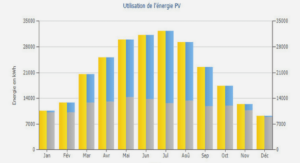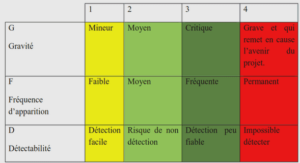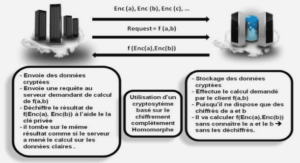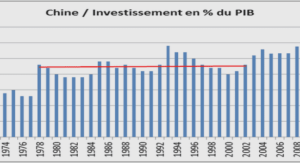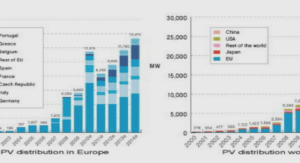Multivariate analyses of evolutionary changes
During the last few decades numerous studies have highlighted the important role of anthropogenic disturbances on the occurrence and speed of contemporary microevolutions in wild populations (reviewed by Hendry & Kinnison, 2001 ; Medina et al., 2007 ; Morgan et al., 2007 ; Hendry et al., 2008). For example, studies have reported cases of increased resistance to heavy metals or pesticides in less than twenty generations in response to strong selection pressures (e.g. Antonovics et al., 1971 ; Klerks & Levinton, 1989 ; Powles et al., 1998 ; Beaudouin et al., 2012). Speed of evolutionary response is assumed to depend on both the intensity of selection pressures and the level standing genetic variation for the trait under selection (Falconer & Mackay, 1996). However, populations can take different evolutionary trajectories in response to the same novel selection pressures. For instance, in response to a pollutant energy allocation can change to favour detoxification mechanisms (Kraaijeveld & Godfrey, 1997 ; Burdon & Thrall, 2003). Alternatively, the pollutant may affect the evolution of life history characteristics, with an evolution towards faster growth that cause a reduction of the internal concentration of the pollutant (Sibly & Calow, 1989). Furthermore, evolution experiments placing populations in presence of a pollutant over multiple generations have shown that after an early quick drop fitness can increase in as fast as six generations (Xie & Klerks, 2003 ; Ward & Robinson, 2005 ; Salice et al., 2010 ; Jansen et al., 2011b). These results indicate that at least in these conditions populations can show quick evolutionary response to selection in a novel environment. Selection induced by pollutants is generally directional, continuous, and strong (Posthuma & Van Straalen, 1993 ; Medina et al., 2007). Nonetheless, wild populations affected by pollution generally live in heterogeneous environments where different selection pressures can act on the organism in different directions (Levins, 1968 ; Hedrick, 1974, 1976, 1986). These differential selection pressures have been shown to help maintaining genetic variation in population, from both a theoretical (Haldane & Jayakar, 1963 ; Gillespie & Turelli, 1989 ; Hedrick, 1995) and empirical point of view (Mackay, 1981 ; Hedrick, 1986 ; Gram & Sork, 2001 ; Roff, 2002b). Furthermore, temporally fluctuating environments seem to favour a generalist rather than a specialist way of life (Reboud & Bell, 1997 ; Cooper & Lenski, 2000 ; Turner & Elena, 2000 ; Cooper & Lenski, 2010). In such a case, populations evolving in an alternating presence of stressors in their environment may cope less with each stressor, and their evolutionary response may be slower, than that of populations that have evolved in response to only one of the stressors.
Material and methods
Population maintenance
We worked with a stock population of C. elegans composed of a mixture of 16 wild isolates (Teotónio et al., 2012) to obtain a large genetic diversity. The population was kept in the experimental conditions described in Teotónio et al.(2012) for over 140 generations, prior to our study, where recombination-selection equilibrium was mostly achieved without significant loss of genetic diversity. The population was composed of around 30% of males for an androdioecious breeding system (i.e. self-fertilization of hermaphrodites and facultative outcross with males). For our study we changed laboratory conditions: we used 500 individuals in a 9 cm diameter Petri plate (6 replicates) with NGM-modified agar (use of HEPES buffer, see article I). Once NGM was dispensed into Petri plates, plates were left in a laminar flow hood one hour to dry NGM. We also grew E. coli OP50 cultures in Lysogeny Broth (LB) rich medium at 37°C overnight. To avoid interaction between LB and uranium in the future U-treatment, we systematically centrifuged bacteria twice, removed the supernatant and re-suspended bacteria with a solution of 85 mM NaCl to obtain a 20:1 mixture of E. coli (OD600nm of 3 in LB). Plates were seeded with 1 ml of this food source and left in a laminar flow hood for one hour to allow the bacterial culture to dry. Then plates were top-exposed to UV doses for 90 s to stop bacterial growth (Bio-Link Crosslinker; λ=254 nm; intensity = 200 µwatt.cm-2 ). The main aim of this UV treatment was to avoid different bacterial growth in control and polluted plates. Every 3 days we washed twice the nematodes off the plates with 3 ml of M9-modified solution (use of HEPES buffer) for each replicate and kept a sample per replicate in 15 ml falcon tubes. The number of individuals in a tube was estimated with five sample drops of 5 µl (see 90 Article III – Multivariate analyses of evolutionary changes Teotónio et al., 2012), and then the volume corresponding to 500 individuals, from all developmental stages, was placed in a fresh Petri plate. This was done to transfer a representative sample of the age structure of the population at each time and avoid unintentional selection of some specific life history strategies. Nematodes were cultured throughout the experiment at 20°C and 80% of relative humidity.
Conditions of pollution
After repeating this protocol forty times (i.e. for about 40 generations), the individuals from the six replicates were mixed before transferring, in four different conditions, 500 individuals per plate (six plates per condition). We maintained the novel populations in similar conditions than previously but changed the medium depending on the four conditions of the experiment: (1) a control environment (see above for medium) and three stressful environments, identical to the control, except for the addition in the NGM-modified agar of (2) 1.1 mM U (uranyl nitrate: UO2 (NO3)2, 6H2O; Sigma-Aldrich, France), (3) 308 mM NaCl or (4) alternating uranium and salt at each generation (in the same conditions as for treatment 2 and 3 and salt for odd generations). Thereafter we will refer to different population evolving in these environments as control, uranium, salt and alternating populations. Uranium and salt concentrations were chosen because they entailed a reduction of fertility by 60% at the first generation of exposition corresponding to a strong selection. In all medium we added 51 mM NaCl as in the classical preparation of NGM (Stiernagle, 2006), except in the salt environment where NaCl-concentration was of 308 mM. In the U-treatment, we also added the volume to obtain a concentration of 1.1 mM U (depending on volume of U-medium to prepare at each generation) of a solution of 50 mM U in NGM still liquid after autoclave. This multigenerational experience of selection lasted 66 days and approximately 22 generations (i.e. one generation per three days).
Traits measurements
During the first four generations we quantified the effects of within-individual and crossgeneration phenotypic plasticity by measuring the traits at each generation. We then measured traits once every three generations until generation 22, except for generation 20 during which – for logistical reasons – we did the measurements instead of generation 19. Populations experienced Article III – Multivariate analyses of evolutionary changes 91 longer generation time in salt, but to simplify we considered a 3-days generation time for all the treatments thereafter. At any given generation, after transferring into a novel 6 cm diameter Petri plate the 500 individuals needed for the next generation, we sampled approximately 200 individuals per replicate and placed them into a new Petri plate with a control agar medium. We then estimated more precisely population size by counting individuals that were left on the Petri plates from the given generation after placing them at 4°C for one hour to slow down the movement of individuals. After cleaning the individuals off the plate, there were still hundreds of eggs adhered to the surface of the plate. We used these eggs for our phenotypic measures. Approximately 100 eggs were taken from the original Petri plate and transferred into a 6 cm diameter Petri plate, contained 10 ml of NGM (same medium than during the three previous generations) and 250 µl of 5:1 UV-killed OP50 (OD600nm of 3), to measure survival and sex-ratio after 48h. We scored as dead eggs that did not hatch and worms that did not move their body or their head in response to three repeated stimulations with a platinum transfer pick (Sutphin & Kaeberlein, 2009). Visual differentiation between males and hermaphrodites starts to be possible at L4 larval stage (Sulston et al., 1980). As the individuals that survived were at least at the L4 stage, we could determine their sex based on morphological criteria. Because of the developmental delay happening in the salt treatment, sex ratio in this treatment was only evaluated at 72h. We measured phenotypic traits on both hermaphrodites and males. To measure brood size, and index of fertility, three hermaphrodites per replicate were transferred individually in a well of a tissue culture plate (12-well, same medium than in the original Petri plate) containing 2 ml of NGM per well and 75 µl of 5:1 UV-killed OP50. Brood size was measured as the number of hatched progeny produced by a hermaphrodite. An index of early and late (hatched progeny produced before and after 96h of age) fertility was also used. We measured morphological traits using pictures of individuals taken with a stereomicroscope (Olympus SZX12, 1.6 x 90 magnification) and a computer-connected camera (Nikon D5000). As for fertility, males and hermaphrodites were measured at 96h. Image analyses for males’ body length were done by a rapid and automatic procedure, used in batch, developed in Matlab (R2010b, Mathworks ©). First a background subtraction is applied and the body is extracted by a classic thresholding method. A skeletonization algorithm is then used to obtain the 92 Article III – Multivariate analyses of evolutionary changes relevant body points, which serve as basis for a spline of interpolation to measure the precise length of each individual (see appendix D for more details on the automatic procedure). We could not measure hermaphrodites with this method because of the presence of bacteria, altering the differentiation of individuals. Consequently, we used ImageJ software (Rasband, 2012) and measured their body length manually. We validated the automatic measures by comparing them with a sample of manual measures in males; and found a very strong correlation between the two methods (r = 0.97, n = 15). Body length was used as an index of growth between 0 to 96h of age. We finally measured male body bend frequency at 96 h, as an index of locomotion behaviour. One body bend equals a change in the direction of the anterior part of the worm (including the posterior bulb of the pharynx) along the Y axis using the body of the worm as the X axis (Tsalik & Hobert, 2003). Individuals on a 6 cm Petri plate were washed twice with washing buffer that permitted a rapid sedimentation of individuals in the liquid. The buffer was composed of 5 mM HEPES, 1 mM CaCl2, 1 mM MgSO4, 0.5 g.l-1 gelatin (Saeki et al., 2001). Then, individuals were placed onto a 6 cm diameter Petri plate containing 10 ml of NGM but no bacteria. After five minutes, we counted the number of body bends over 20 s of three males per replicate. We focused on male body bend: in addition to providing movements necessary for finding the good living conditions in both males and hermaphrodites, locomotion behaviour is also necessary for males to encounter and fertilize hermaphrodites (Pannell, 2002 ; Barrière & Félix, 2005a).
